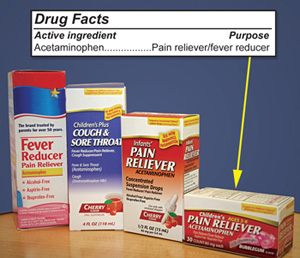Reducing Fever in Children: Safe Use of Acetaminophen
On This Page:
- Advice From Outside Experts
- FDA Acts to Change Prescription Labels
- Tips for Giving Acetaminophen to Children
You’re in the drug store, looking for a fever-reducing medicine for your children. They range in age from 6 months to 7 years, and you want to buy one product you can use for all of them. So you buy liquid acetaminophen in concentrated drops for infants, figuring you can use the dropper for the baby and a teaspoon for the oldest.
This could be a dangerous mistake.
This use of concentrated drops in much larger amounts—as would be given with a teaspoon—can cause fatal overdoses, says Sandra Kweder, M.D., deputy director of the Food and Drug Administration’s Office of New Drugs.
You can’t just give an older child more of an infant’s medicine, adds Kweder. “Improper dosing is one of the biggest problems in giving acetaminophen to children.”
Confusion about dosing is partly caused by the availability of different formulas, strengths, and dosage instructions for different ages of children.
Sold as a single active ingredient under such brand names as Tylenol, acetaminophen is commonly used to reduce fever and relieve pain. It is also used in combination with other ingredients in products to relieve multiple symptoms, such as cough and cold medicines. Acetaminophen can be found in more than 600 over-the-counter (OTC, or non-prescription) and prescription medicines.
Improper dosing is one of the biggest problems in giving acetaminophen to children.
Acetaminophen is generally safe and effective if you follow the directions on the package, but if you give a child even a little more than directed or give more than one medicine that contains acetaminophen, it can cause nausea and vomiting, says Kweder.
In some cases—in both adults and children—it can cause liver failure and death. In fact, acetaminophen poisoning is a leading cause of liver failure in the U.S.
Advice From Outside Experts
An FDA Advisory Panel of outside experts met May 17-18, 2011, to discuss how to minimize medication errors and make children’s OTC medicines that contain acetaminophen safer to use.
The panel recommended:
- That liquid, chewable, and tablet forms be made in just one strength. Currently, there are seven strengths available for these forms combined.
- That dosing instructions to reduce fever be developed for children as young as 6 months. Current instructions apply to children ages 2 to 12 years and for those under 2, only state “consult a doctor.”
- That dosing instructions be based on weight, not just age.
- Setting standards for dosing devices, such as spoons and cups, for children’s medicines. Currently, some use milliliters (mL) while others use cubic centimeters (cc) or teaspoons (tsp).
“FDA is considering these recommendations,” says Kweder, and for those that the agency adopts, “we will work with manufacturers to try to get them in place on a voluntary basis.” The process of getting a regulation finalized could take several years, she adds, so having the drug industry act voluntarily would help make acetaminophen safer sooner.
Drug makers have already agreed to phase out the concentrated infant drops to reduce confusion for parents who try to use them for older children. On May 4, 2011, the Consumer Healthcare Products Association, a trade group representing the makers of OTC medicines, announced plans to convert liquid acetaminophen products for children to just one strength (160 mg/5 mL). In addition, the industry is voluntarily standardizing the unit of measurement “mL” on dosing devices for these products.
FDA Acts to Change Prescription Labels
Under a 2009 FDA regulation, manufacturers must place the word “acetaminophen” on the front of the package of all OTC products that contain the ingredient and on the “Drug Facts” label on the container and packaging.
However, prescription medicines don’t have Drug Facts labels. Instead, the pharmacy places a computer-printed label based on the doctor’s prescription on the container before giving it to the consumer. Pharmacies often use the acronym “APAP” (N-acetyl-p-aminophenol) or a shortened version of acetaminophen to represent the ingredient. If parents don’t know these abbreviations, they might not recognize that a prescription medicine contains acetaminophen and could accidentally overdose a child by giving a prescription and an OTC acetaminophen medicine at the same time.
FDA’s Safe Use Initiative, which fosters collaborations within the health care community to help prevent harm from medications, has been working to bring about the complete spelling of acetaminophen on prescription containers.
Tips for Giving Acetaminophen to Children
- Never give your child more than one medicine containing acetaminophen at a time. To find out if an OTC medicine contains acetaminophen, look for “acetaminophen” on the Drug Facts label under the section called “Active Ingredient.” For prescription pain relievers, ask the pharmacist if the medicine contains acetaminophen.
- Choose the right OTC medicine based on your child’s weight and age. The “Directions” section of the Drug Facts label tells you if the medicine is right for your child and how much to give. If a dose for your child’s weight or age is not listed on the label or you can’t tell how much to give, ask your pharmacist or doctor what to do.
- Never give more of an acetaminophen-containing medicine than directed. If the medicine doesn’t help your child feel better, talk to your doctor, nurse, or pharmacist.
- If the medicine is a liquid, use the measuring tool that comes with the medicine—not a kitchen spoon.
- Keep a daily record of the medicines you give to your child. Share this information with anyone who is helping care for your child.
- If your child swallows too much acetaminophen, get medical help right away, even if your child doesn’t feel sick. For immediate help, call the 24-hour Poison Control Center at 800-222-1222, or call 911.
This article appears on FDA's Consumer Updates page, which features the latest on all FDA-regulated products.
July 21, 2011
Return to FDA Consumer Articles

